WRITE A RULE TO DESCRIBE REFLECTION
Subscribe to our ▶️ YouTube channel 🔴 for the latest videos, updates, and tips.
Types of Reflection and Its Rules
|
Reflection over x axis Reflection over y axis Reflection over y = x Reflection over y = -x Reflection about origin |
(x, y) ==> (x, -y) (x, y) ==> (-x, y) (x, y) ==> (y, x) (x, y) ==> (-y, -x) (x, y) ==> (-x, -y) |
Reflection about horizontal and vertical lines :
For horizontal line of reflection, the vertical distance between a point and its reflection point will be the same from the line of reflection.
For vertical line of reflection, the horizontal distance between a point and its reflection point will be the same from the line of reflection.
Write a rule to describe each transformation.
Problem 1 :
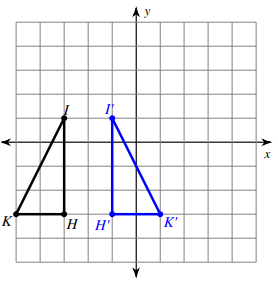
Solution :
Comparing the corresponding coordinates of two shapes,
H(-3, -3) ==> H'(-1, -3)
I(-3, 1) ==> I'(-1, 1)
K(-5, -3) ==> K'(1, -3)
There is no change in y-coordinates, by observing the triangles from -2 on the x coordinate
H and H' are at the same distance
K and K' are at the same distance
I and I' are at the same distance
So, there is vertical line of reflection and
line of reflection at x = -2
Problem 2 :
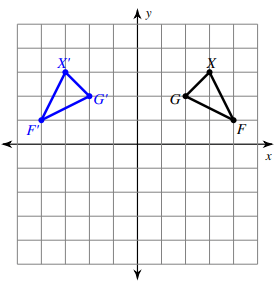
Solution :
Comparing the corresponding coordinates of two shapes,
G(2, 2) ==> G'(-2, 2)
X(3, 3) ==> X'(-3, 3)
F(4, 1) ==> F'(-4, 1)
There is no change in y-coordinates, comparing x-coordinates, the signs alone is changed.
So,
reflection across y-axis.
Problem 3 :
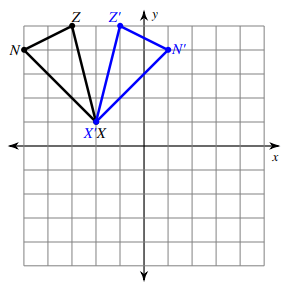
Solution :
Comparing the corresponding coordinates of two shapes,
X(-2, 1) ==> X'(-2, 1)
N(-5, 4) ==> N'(1, 4)
Z(-3, 5) ==> F'(-1, 5)
There is no change in y-coordinates, x coordinates are changed except X. So, there may be horizontal or vertical line of reflection.
From -2 on the x-coordinate N and N' are at the same distance. Z and Z' are at the same distance. Then, there is vertical line of reflection and it is
reflection across x = -2
Problem 4 :
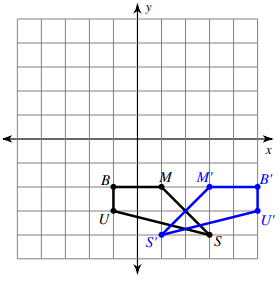
Solution :
Comparing the corresponding coordinates of two shapes,
S (3, -4) ==> S' (1, -4)
M (1, -2) ==> M' (-3, -2)
B (-1, -2) ==> B' (-5, -2)
U (-1, -3) ==> U' (-5, -3)
There is no change in y-coordinates, x coordinates are changed.
From 2 on the x-coordinate
- S and S' are at the same distance.
- M and M' are at the same distance.
- B and B' are at the same distance.
- U and U' are at the same distance.
So,
reflection across x = 2
Problem 5 :
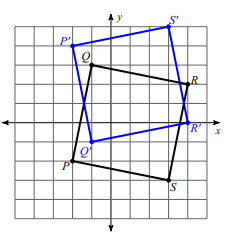
Solution :
Comparing the corresponding coordinates of two shapes,
Q (-1, 3) ==> Q' (-1, -1)
P (-2, -2) ==> P' (-2, 4)
S (3, 3) ==> S' (3, 5)
R (4, 2) ==> R' (-5, -3)
There is no change in x-coordinates, y coordinates are changed.
From 1 on the y-coordinate the vertical distance, so there may be horizontal reflection.
- Q and Q' are at the same distance.
- P and P' are at the same distance.
- S and S' are at the same distance.
- R and R' are at the same distance.
So,
reflection across y = 1
Problem 6 :
L(0, 1), K(0, 2), J(3, 3), I(5, 1)
to
L'(0, -1), K'(0, -2), J'(3, -3), I'(5, -1)
Solution :
By comparing the corresponding coordinates
L (0, 1) ==> L' (0, -1)
K (0, 2) ==> K' (0, -2)
J (3, 3) ==> J' (3, -3)
I (5, 1) ==> I' (5, -1)
There is no change in x-coordinate. (x, y) ==> (x, -y)
So,
Reflection across x-axis.
Subscribe to our ▶️ YouTube channel 🔴 for the latest videos, updates, and tips.
Recent Articles
-
Finding Range of Values Inequality Problems
May 21, 24 08:51 PM
Finding Range of Values Inequality Problems -
Solving Two Step Inequality Word Problems
May 21, 24 08:51 AM
Solving Two Step Inequality Word Problems -
Exponential Function Context and Data Modeling
May 20, 24 10:45 PM
Exponential Function Context and Data Modeling